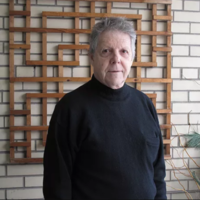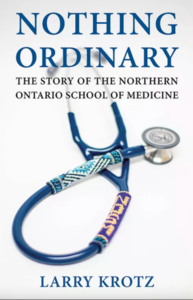Larry Krotz on Telling the Story of the Medical School that Changed the Lives of People Across Northern Ontario
Northern Ontario is famous for its rugged beauty and unspoiled natural resources. But it's easy to forget just how big the region also is, and the challenges that scale can create. With just a tenth of the population of the rest of the province, North Ontario encompasses more land than Italy and Germany — combined. This spread-out population creates issues for some services, but particularly for access to medical care, both longterm and emergency. It was a problem for decades, with little hope on the horizon, especially for smaller rural, Indigenous, and Francophone communities.
Then in 2005, something astonishing happened. The people of Northern Ontario came together, partnering with Laurentian and Lakehead Universities, to create a medical school aimed at training and retaining doctors in Northern Ontario, for Northern Ontario.
It was an enormous undertaking, and its formation and effect on the region is explored in Larry Krotz's fascinating new book Nothing Ordinary: The Story of the Northern Ontario School of Medicine (Cormorant Books). The NOSM has transformed medical care in Northern Ontario, and we're excited to welcome Larry to Open Book today to discuss its legacy as part of our True Story nonfiction interview series.
He tells us about the intensive research process for Nothing Ordinary, which included nearly fifty interviews, reveals how a "nonfiction project is a lot like a physical building project", and shares his nonfiction heroes.
Open Book:
Tell us about your new book and how it came to be. What made you passionate about the subject matter you're exploring?
Larry Krotz:
Nothing Ordinary is the story of how 800,000 people in northern Ontario invented their own medical school at a time, twenty years ago, when the region suffered perennial frustrations about having enough doctors to adequately serve it. I’ve long been interested in ‘the North’ or non-metropolitan Canada and this story seemed a prime opportunity to look at a very important topic. Also, I was intrigued by how many people in southern Ontario had never heard of the Northern Ontario School of Medicine, so felt I had an opportunity to educate an audience about something they might even think exotic.
OB:
What was your research process like for this book? Did you encounter anything unexpected while you were researching?
LK:
The research process involved a great deal of travel as I interviewed about fifty subjects. Northern Ontario is sparsely populated with great distances between centres of settlement even when those are cities. So I stayed in a lot of different motels. I wanted to hear from graduates of the school who were out now serving as physicians in various communities as well as mayors and Indigenous leaders who had opinions about what the school has meant to life in their communities. The school was exceedingly cooperative and helpful in connecting me to sources and interviews.
OB:
What do you love about writing nonfiction? What are some of the strengths of the genre, in your opinion?
LK:
If journalism is the first draft of history, nonfiction or documentary is the refined second draft – not quite academic history yet but an opportunity for a more settled perspective. I particularly like the interview aspect of it, the process of listening and prodding people to probe their own perspectives.
Your CanLit News
Subscribe to Open Book’s newsletter to get local book events, literary content, writing tips, and more in your inbox
OB:
A lot of nonfiction prizes and anthologies have expanded to welcome more personal nonfiction as well as strictly research-based nonfiction. What do you think of this shift within the genre?
LK:
The 'all my struggles' or 'all my triumphs' books seem a bit narcissistic for my taste.
OB:
What do you do if you're feeling discouraged during the writing process? Do you have a method of coping with the difficult points in your projects?
LK:
I’ve been doing this a long time. It’s mainly about getting up in the morning and going to work. A large nonfiction project is a lot like a physical building project. There are stages. You decide what you want – a cottage? a high rise? You check out the site. You make an architectural plan. Then you dig a foundation, order supplies, start laying bricks. There is no magic. Someone, I think Philip Roth said: amateurs look for inspirations, the rest of us just get up and go to work.
OB:
Did you write this book in the order it appears for readers? If not, how did it come together during the writing process?
LK:
Nothing Ordinary, being the story of how a medical school came together and got through its first fifteen years, had a logical chronological flow. First there was the dream, then the politics, then the mechanics and then the evaluations. I tried to adhere to this natural structure punctuating it regularly with inputs from various evaluators – graduates, the experiences of various communities.
OB:
What defines a great work of nonfiction, in your opinion? Tell us about one or two books you consider to be truly great books.
LK:
A great work needs to be readable and entertaining all the while leaving you with the feeling you are definitely learning something. My nonfiction heroes are Paul Theroux and Ryzard Kapuscinski. Both take their readers along on journeys into the wild unknown.
_________________________________________
Larry Krotz is a writer and documentary filmmaker who has worked with the Globe and Mail, the National Post, the Literary Review of Canada, the National Film Board of Canada, and PBS. He is the author of ten works of non-fiction, a novel, and a picture book. His latest book is a history of the Northern Ontario School of Medicine called Nothing Ordinary. Krotz currently lives in Toronto, ON.





